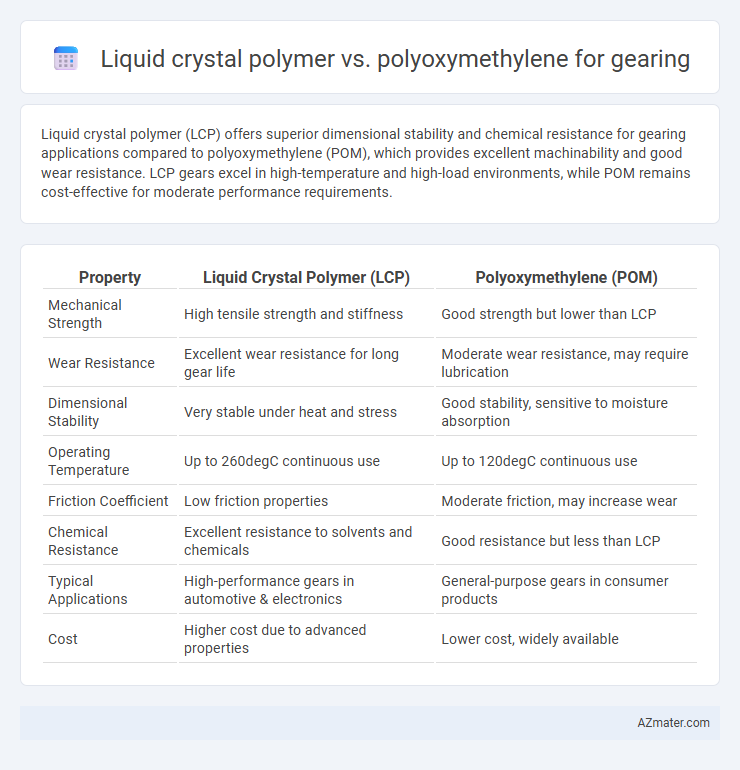Liquid crystal polymer (LCP) offers superior dimensional stability and chemical resistance for gearing applications compared to polyoxymethylene (POM), which provides excellent machinability and good wear resistance. LCP gears excel in high-temperature and high-load environments, while POM remains cost-effective for moderate performance requirements.
Table of Comparison
| Property | Liquid Crystal Polymer (LCP) | Polyoxymethylene (POM) |
|---|---|---|
| Mechanical Strength | High tensile strength and stiffness | Good strength but lower than LCP |
| Wear Resistance | Excellent wear resistance for long gear life | Moderate wear resistance, may require lubrication |
| Dimensional Stability | Very stable under heat and stress | Good stability, sensitive to moisture absorption |
| Operating Temperature | Up to 260degC continuous use | Up to 120degC continuous use |
| Friction Coefficient | Low friction properties | Moderate friction, may increase wear |
| Chemical Resistance | Excellent resistance to solvents and chemicals | Good resistance but less than LCP |
| Typical Applications | High-performance gears in automotive & electronics | General-purpose gears in consumer products |
| Cost | Higher cost due to advanced properties | Lower cost, widely available |
Introduction to High-Performance Gear Materials
Liquid crystal polymer (LCP) offers exceptional stiffness, low friction, and high dimensional stability, making it ideal for high-performance gearing applications requiring precision and durability. Polyoxymethylene (POM), also known as acetal, provides excellent wear resistance and low moisture absorption, commonly used in gears demanding moderate strength and smooth operation. Both materials optimize gear performance by balancing mechanical properties and environmental resistance, with LCP suited for high-load, high-speed environments and POM preferred for cost-effective, reliable gear solutions.
Overview of Liquid Crystal Polymer (LCP)
Liquid Crystal Polymer (LCP) is a high-performance engineering thermoplastic known for its exceptional strength, stiffness, and thermal stability, making it ideal for precision gearing applications. Its molecular alignment during processing results in excellent dimensional stability and low coefficient of friction, which reduces wear and enhances gear longevity compared to Polyoxymethylene (POM). LCP's inherent chemical resistance and low moisture absorption contribute to superior performance in demanding environments where POM may degrade or swell.
Understanding Polyoxymethylene (POM)
Polyoxymethylene (POM), also known as acetal, exhibits high stiffness, excellent dimensional stability, and low friction, making it a preferred material for precision gearing applications. Compared to liquid crystal polymer (LCP), POM offers better impact resistance and easier manufacturability, though LCP provides superior wear resistance and heat tolerance. POM's ability to withstand continuous mechanical stress and resist moisture absorption enhances gear performance in automotive, consumer electronics, and industrial machinery.
Mechanical Properties Comparison
Liquid crystal polymer (LCP) exhibits superior mechanical properties for gearing applications, including higher tensile strength, excellent dimensional stability, and outstanding wear resistance compared to polyoxymethylene (POM). LCP's unique molecular alignment results in greater stiffness and thermal stability, enabling gear components to maintain performance under high stress and elevated temperatures where POM may deform or degrade. While POM offers good impact resistance and low friction, LCP's enhanced fatigue resistance and self-lubricating characteristics make it ideal for precision gears demanding prolonged reliability and minimal maintenance.
Wear and Friction Performance
Liquid crystal polymers (LCP) offer superior wear resistance and lower friction coefficients compared to polyoxymethylene (POM) in gearing applications, resulting in longer service life and enhanced operational efficiency. The molecular orientation and inherent stiffness of LCP contribute to reduced material abrasion and superior dimensional stability under high-load conditions. Polyoxymethylene, while exhibiting good wear properties, tends to have higher friction and lower thermal stability, which can lead to increased wear and potential gear failure in demanding environments.
Chemical and Thermal Resistance
Liquid crystal polymer (LCP) exhibits superior chemical resistance compared to polyoxymethylene (POM), maintaining structural integrity in harsh solvents and aggressive chemicals often encountered in industrial gearing applications. LCP also outperforms POM in thermal resistance, with a heat deflection temperature typically above 260degC, allowing gears to operate reliably under sustained high temperatures. In contrast, POM's lower melting point around 175degC limits its usage in environments requiring prolonged thermal stability or exposure to high-temperature chemicals.
Dimensional Stability in Gearing Applications
Liquid crystal polymer (LCP) exhibits superior dimensional stability compared to polyoxymethylene (POM) in gearing applications due to its highly oriented molecular structure, which minimizes thermal expansion and creep under load. LCP's low moisture absorption and exceptional resistance to high temperatures ensure consistent gear precision and long-term reliability in demanding environments. In contrast, POM, while offering good wear resistance and machinability, is more susceptible to dimensional changes from moisture uptake and thermal fluctuation, potentially impacting gear performance and longevity.
Processing and Manufacturability
Liquid crystal polymer (LCP) offers superior dimensional stability and chemical resistance during molding, making it ideal for high-precision gearing with complex geometries. Polyoxymethylene (POM) provides easier machinability and lower processing temperatures, facilitating cost-effective production for standard gear components. Both materials require specific injection molding parameters, but LCP demands stricter control to prevent thermal degradation and maintain mechanical properties.
Cost Analysis: LCP vs POM
Liquid crystal polymer (LCP) gears typically exhibit higher upfront costs compared to polyoxymethylene (POM) due to advanced processing requirements and raw material expenses. Despite the premium, LCP offers superior mechanical strength, thermal stability, and wear resistance, potentially reducing long-term maintenance and replacement costs. In contrast, POM gears provide a cost-effective solution with adequate performance for moderate load applications but may incur higher lifecycle costs due to susceptibility to wear and environmental degradation.
Application Suitability and Industry Use Cases
Liquid crystal polymer (LCP) offers exceptional dimensional stability, high mechanical strength, and excellent wear resistance, making it ideal for precision gearing applications in the automotive and aerospace industries where performance under high stress and temperature is critical. Polyoxymethylene (POM), known for its low friction, high stiffness, and good machinability, is widely used in consumer electronics, appliances, and industrial machinery gears that require cost-effective and reliable operation in moderate load conditions. While LCP gears excel in high-performance, demanding environments, POM gears are preferred for general-purpose applications where durability and ease of manufacturing are prioritized.

Infographic: Liquid crystal polymer vs Polyoxymethylene for Gearing
 azmater.com
azmater.com